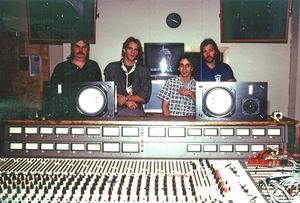Difference between revisions of "Unique Recording Studios"
(→See also) |
m (→See also) |
||
| Line 40: | Line 40: | ||
Scoring started a couple of weeks before the Pilot episode was aired (on September 18, [[1985]]). | Scoring started a couple of weeks before the Pilot episode was aired (on September 18, [[1985]]). | ||
| + | |||
| + | |||
Michael Finlayson: "The original Pilot had been scored by Lalo Schifrin, but didn’t work I guess, so they got Stewart. By then they (the producers) had lost most of their lead time so they were literally shooting two weeks before air and we were working on the music the week before air. The show we were working on aired days after we finished. As I recall, I worked on the pilot and the first four shows, but that gets into October. | Michael Finlayson: "The original Pilot had been scored by Lalo Schifrin, but didn’t work I guess, so they got Stewart. By then they (the producers) had lost most of their lead time so they were literally shooting two weeks before air and we were working on the music the week before air. The show we were working on aired days after we finished. As I recall, I worked on the pilot and the first four shows, but that gets into October. | ||
Revision as of 11:08, 6 September 2012
| Unique Recording Studios | |
|---|---|
| Location: | New York, NY, USA |
| Years in operation: | 1978 - 2004 |
In September 1985 Stewart Copeland worked on The Equalizer score in New York before moving to The Hit Factory.
History
This section needs more information.
Recording history
The following Police and related albums or songs were recorded at this studio:
| Album (or song) title | Artist or band | Producer | Release year |
|---|---|---|---|
| The Equalizer | Stewart Copeland | Stewart Copeland | YYYY |
See also
In September 1985 - roughly from September 4 to about September 26 - Stewart Copeland and Jeff Seitz worked on the score of The Equalizer at Unique Recording Studios, before continuing their work at The Hit Factory.
Michael Finlayson was the engineer with Jeff Lord assisting. The photo with all four of them was taken in Studio B, but most of the work was done in Studio C (aka "Midi City").
Scoring started a couple of weeks before the Pilot episode was aired (on September 18, 1985).
Michael Finlayson: "The original Pilot had been scored by Lalo Schifrin, but didn’t work I guess, so they got Stewart. By then they (the producers) had lost most of their lead time so they were literally shooting two weeks before air and we were working on the music the week before air. The show we were working on aired days after we finished. As I recall, I worked on the pilot and the first four shows, but that gets into October.
Once we started the EQ we worked 14 hours a day, seven days a week... We worked EVERY day. I do remember one day off so Stewart could fly down to Florida to play polo. And we took the night off the for the MTV Video Music Awards on September 13.
Stewart asked Jeff (Seitz) to go buy him a shirt to wear, because we were always under the gun and if he was taking the night off, and we were going to meet deadline, there was no way he was leaving the studio. Jeff came back with a shirt. An EIGHT HUNDRED DOLLAR shirt. And this is 1985 dollars. I probably said 'WHAT?!?!" or at least audibly gasped and Stewart turned and said, "That's one thing about making so much money. I've lost track of the value of a dollar. I know the value of a thousand dollars or ten thousand, but not a dollar." That is not an exact quote, but the concept is there. This was proven true a few times when we let Stewart order lunch. We were used to getting a sandwich or meatball hero sent in. Maybe $3. He'd send somebody to a restaurant and then we'd find out when the food came that our share was $20! It was always delicious though. Ha!
I don't know if you want to use this, but it was another interesting evening on the project. Stevie Nicks was downstairs in Studio A. She wanted Stewart to come down and play hi-hat on her record. As I recall he was going to blow her off and then he got an idea to have her do her trademark scatting over the intro theme of the Equalizer. "Midi City" had a large control room and a booth maybe 6x6 or 8x8 feet. She agreed. So I set up a mic and a small tv monitor for playback in the dimly lit booth. Meanwhile, Stevie and her assistant (whose main job appeared to be to manage Stevie's alcohol and/or pharmaceuticals) listened to the track in the control room. When I was set, Stevie went in and started singing along with the track. We did multiple takes and she just seemed to be meandering, not really emphasizing or locking in with the visuals. I pushed talkback and Stewart said something to the effect of "just watch the TV and try and highlight the action onscreen." I lifted the talkback and she responded, "What TV?" She was standing in a small dark room with a TV not three feet from her face. I think we called it after that. I don't think Stewart ever made it down to Studio A. The saddest part of this story is that I saved those outtakes, probably on beta-hifi. When beta went the way of the dodo, so did all my old tapes. Wish I had that one back. It actually sound pretty cool."
External links
References
source: Michael Finlayson
